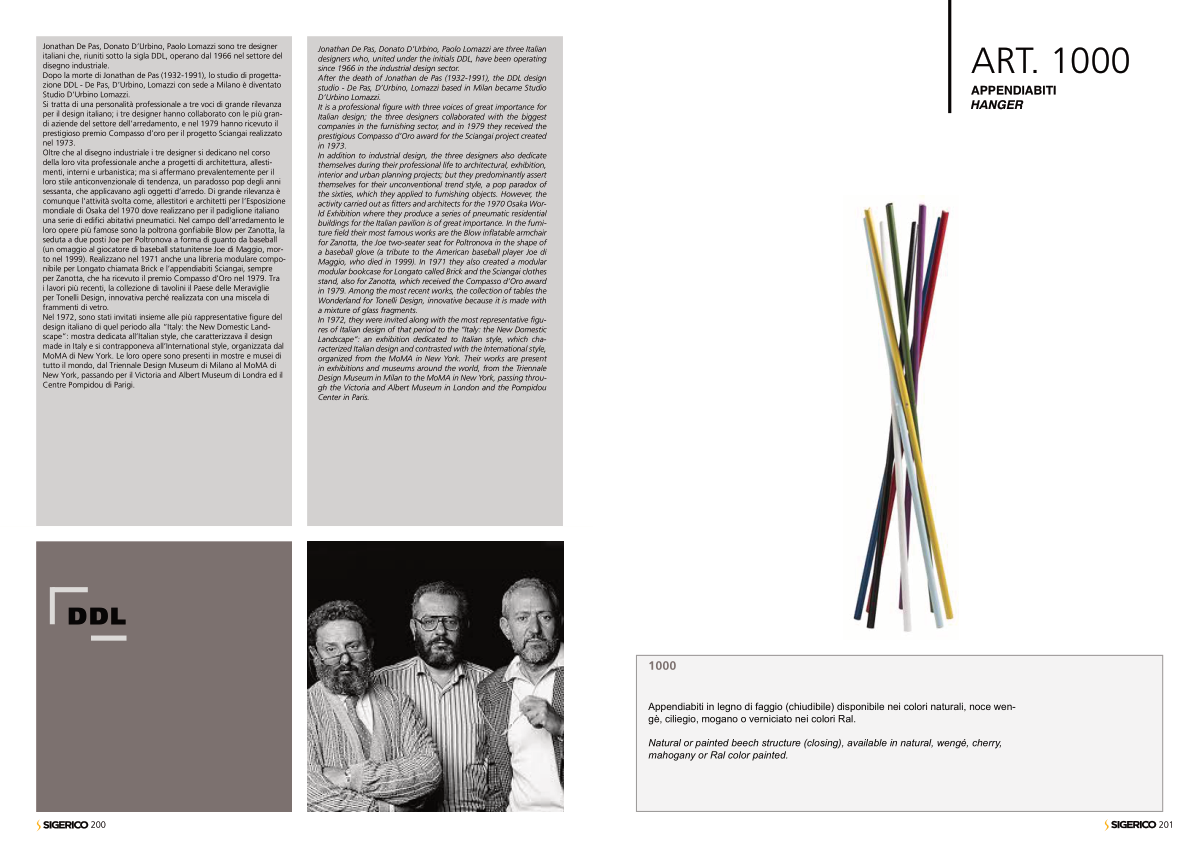Jonathan De Pas, Donato D’Urbino, Paolo Lomazzi sono tre designer
italiani che, riuniti sotto la sigla DDL, operano dal 1966 nel settore del
disegno industriale.
Dopo la morte di Jonathan de Pas (1932-1991), lo studio di progetta-
zione DDL - De Pas, D’Urbino, Lomazzi con sede a Milano è diventato
Studio D’Urbino Lomazzi.
Si tratta di una personalità professionale a tre voci di grande rilevanza
per il design italiano; i tre designer hanno collaborato con le più gran-
di aziende del settore dell’arredamento, e nel 1979 hanno ricevuto il
prestigioso premio Compasso d’oro per il progetto Sciangai realizzato
nel 1973.
Oltre che al disegno industriale i tre designer si dedicano nel corso
della loro vita professionale anche a progetti di architettura, allesti-
menti, interni e urbanistica; ma si affermano prevalentemente per il
loro stile anticonvenzionale di tendenza, un paradosso pop degli anni
sessanta, che applicavano agli oggetti d’arredo. Di grande rilevanza è
comunque l’attività svolta come, allestitori e architetti per l’Esposizione
mondiale di Osaka del 1970 dove realizzano per il padiglione italiano
una serie di edifici abitativi pneumatici. Nel campo dell’arredamento le
loro opere più famose sono la poltrona gonfiabile Blow per Zanotta, la
seduta a due posti Joe per Poltronova a forma di guanto da baseball
(un omaggio al giocatore di baseball statunitense Joe di Maggio, mor-
to nel 1999). Realizzano nel 1971 anche una libreria modulare compo-
nibile per Longato chiamata Brick e l’appendiabiti Sciangai, sempre
per Zanotta, che ha ricevuto il premio Compasso d’Oro nel 1979. Tra
i lavori più recenti, la collezione di tavolini il Paese delle Meraviglie
per Tonelli Design, innovativa perché realizzata con una miscela di
frammenti di vetro.
Nel 1972, sono stati invitati insieme alle più rappresentative figure del
design italiano di quel periodo alla “Italy: the New Domestic Land-
scape”: mostra dedicata all’Italian style, che caratterizzava il design
made in Italy e si contrapponeva all’International style, organizzata dal
MoMA di New York. Le loro opere sono presenti in mostre e musei di
tutto il mondo, dal Triennale Design Museum di Milano al MoMA di
New York, passando per il Victoria and Albert Museum di Londra ed il
Centre Pompidou di Parigi.
Jonathan De Pas, Donato D’Urbino, Paolo Lomazzi are three Italian
designers who, united under the initials DDL, have been operating
since 1966 in the industrial design sector.
After the death of Jonathan de Pas (1932-1991), the DDL design
studio - De Pas, D’Urbino, Lomazzi based in Milan became Studio
D’Urbino Lomazzi.
It is a professional figure with three voices of great importance for
Italian design; the three designers collaborated with the biggest
companies in the furnishing sector, and in 1979 they received the
prestigious Compasso d’Oro award for the Sciangai project created
in 1973.
In addition to industrial design, the three designers also dedicate
themselves during their professional life to architectural, exhibition,
interior and urban planning projects; but they predominantly assert
themselves for their unconventional trend style, a pop paradox of
the sixties, which they applied to furnishing objects. However, the
activity carried out as fitters and architects for the 1970 Osaka Wor-
ld Exhibition where they produce a series of pneumatic residential
buildings for the Italian pavilion is of great importance. In the furni-
ture field their most famous works are the Blow inflatable armchair
for Zanotta, the Joe two-seater seat for Poltronova in the shape of
a baseball glove (a tribute to the American baseball player Joe di
Maggio, who died in 1999). In 1971 they also created a modular
modular bookcase for Longato called Brick and the Sciangai clothes
stand, also for Zanotta, which received the Compasso d’Oro award
in 1979. Among the most recent works, the collection of tables the
Wonderland for Tonelli Design, innovative because it is made with
a mixture of glass fragments.
In 1972, they were invited along with the most representative figu-
res of Italian design of that period to the “Italy: the New Domestic
Landscape”: an exhibition dedicated to Italian style, which cha-
racterized Italian design and contrasted with the International style,
organized from the MoMA in New York. Their works are present
in exhibitions and museums around the world, from the Triennale
Design Museum in Milan to the MoMA in New York, passing throu-
gh the Victoria and Albert Museum in London and the Pompidou
Center in Paris.
DDL
ART. 1000
APPENDIABITI
HANGER
Appendiabiti in legno di faggio (chiudibile) disponibile nei colori naturali, noce wen-
gè, ciliegio, mogano o verniciato nei colori Ral.
Natural or painted beech structure (closing), available in natural, wengé, cherry,
mahogany or Ral color painted.
201
200
1000


